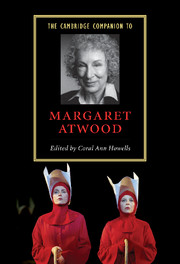Book contents
- Frontmatter
- Introduction
- 1 Margaret Atwood in her Canadian context
- 2 Biography/autobiography
- 3 Power politics: power and identity
- 4 Margaret Atwood’s female bodies
- 5 Margaret Atwood and environmentalism
- 6 Margaret Atwood and history
- 7 Home and nation in Margaret Atwood’s later fiction
- 8 Margaret Atwood’s humor
- 9 Margaret Atwood’s poetry and poetics
- 10 Margaret Atwood’s short stories and shorter fictions
- 11 Margaret Atwood’s dystopian visions: The Handmaid’s Tale and Oryx and Crake
- 12 Blindness and survival in Margaret Atwood’s major novels
- Further Reading
- Index
4 - Margaret Atwood’s female bodies
Published online by Cambridge University Press: 28 November 2006
- Frontmatter
- Introduction
- 1 Margaret Atwood in her Canadian context
- 2 Biography/autobiography
- 3 Power politics: power and identity
- 4 Margaret Atwood’s female bodies
- 5 Margaret Atwood and environmentalism
- 6 Margaret Atwood and history
- 7 Home and nation in Margaret Atwood’s later fiction
- 8 Margaret Atwood’s humor
- 9 Margaret Atwood’s poetry and poetics
- 10 Margaret Atwood’s short stories and shorter fictions
- 11 Margaret Atwood’s dystopian visions: The Handmaid’s Tale and Oryx and Crake
- 12 Blindness and survival in Margaret Atwood’s major novels
- Further Reading
- Index
Summary
By writing herself, woman will return to the body which has been more than confiscated from her, which has been turned into the uncanny stranger on display.
Margaret Atwood's female protagonists show marked signs of bodily unease. From Marian's socio-political anorexia in The Edible Woman, to Elaine's shape-shifting in Cat's Eye, through Joan's aggressive consumption in Lady Oracle, and towards Iris's vicious verbal annihilations of her aging body in The Blind Assassin, Atwood's fictional female bodies become battlefields where anxieties relating to wider power structures are written onto female flesh. This chapter explores Atwood's writing of the female body, which in turn opens up debates relating to her analysis of power politics within a lived socio-culture. In addition, her writing of the female body (which often belongs to female writers or artists) raises dominant critical issues within women's writing and these issues refract back on Atwood's novels and cast new light upon them.
No reader could miss Atwood's preoccupation with the female body and nor could the reader fail to be aware of the various ways in which the body becomes associated with shape-shifting, masquerade, crisis, or play in these novels. Often Atwood dips into Gothic parody or carnivalesque grotesquerie in her writing of the female body; repeatedly it is written in terms of surveillance and hiddenness and it is connected with ideas of incarceration; it is linked with metaphors of disembodiment, a failure to be completely there, or with the occupation of liminal territories which mark uneasy gaps between “real” and “other”; the relationship between mind and body is stressed constantly so that fractured or disrupted psyches result in alienated bodies that become sinister enemies even to their inhabitants; the body is the site of diseases of the breast and the womb, of bad hearts and evil eyes; it is the site on which political power is exercised and the site on which abuse is practiced and in turn rehearsed.
- Type
- Chapter
- Information
- The Cambridge Companion to Margaret Atwood , pp. 58 - 71Publisher: Cambridge University PressPrint publication year: 2006
- 18
- Cited by



